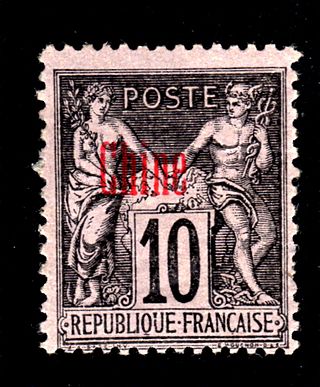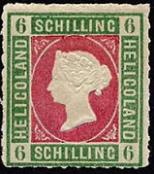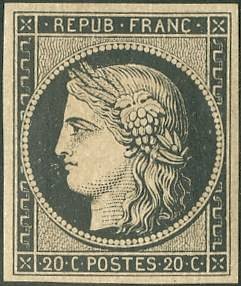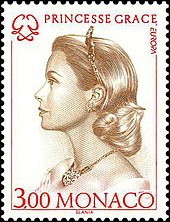
Philately is the study of postage stamps and postal history. It also refers to the collection and appreciation of stamps and other philatelic products. While closely associated with stamp collecting and the study of postage, it is possible to be a philatelist without owning any stamps. For instance, the stamps being studied may be very rare or reside only in museums.

Philatelic literature is written material relating to philately, primarily information about postage stamps and postal history.

Philip Ferrari de La Renotière was a noted French-born stamp collector, assembling probably the most complete worldwide collection that ever existed, or is considered likely to exist. Among his extremely rare stamps were the unique Treskilling Yellow of Sweden and the 1856 one-cent "Black on Magenta" of British Guiana.

The French post offices in China were among the post offices maintained by foreign powers in China from the mid-19th century until 1922. The first civilian French Post Office in Shanghai, China opened in 1862. Initially, the French government used ordinary French postage stamps e.g. Napoleon III, Laureated Empire, Ceres and Sage issues for these offices. These forerunner stamps can be shown to have been sold or used in China only by a postmark. Stamps used at Shanghai prior to 1894, for example, can only be identified by diamond-shaped cancel made of a type referred to as a “losange à gros chiffres” with the numbers "5104" in the center of the cancel or a Shanghai c.d.s. There are actually two types of "5104" obliterators differ by the shape of the "4", one straight and the other curved.

The Mauritius "Post Office" stamps were issued by the British Colony Mauritius in September 1847, in two denominations: an orange-red one penny (1d) and a deep blue two pence (2d). Their name comes from the wording on the stamps reading "Post Office", which was soon changed in the next issue to "Post Paid". They are among the rarest postage stamps in the world.

This is a survey of the postage stamps and postal history of Romania.

During the period when Heligoland was a British possession, about 20 postage stamps were issued between 1867 and 1890. There were up to eight printings of a single denomination and also a large volume of reprints which are known as the Berlin, Leipzig and Hamburg Reprints, respectively. The Berlin reprints are sometimes better quality than the originals. The reprints were done between 1875 and 1895. Consequently, many "old" collections contain reprints rather than originals. Some believe there were seven million reprints as compared to the known 1½ million originals, of which perhaps half were sold through the post office and the remainder sold to dealers when withdrawn from use. A few printings were never postally sold but nevertheless found their way into the hands of dealers. The stamps were printed by the Prussian State Printing Office in Berlin. They were denominated in the Hamburg Schilling until 1875, when both German Reich and British values appeared on each stamp issue. All are embossed with a silhouette of Queen Victoria excepting the four highest values which represent Heligoland escutcheons.

In general, philatelic fakes and forgeries are labels that look like postage stamps but have been produced to deceive or defraud. Learning to identify these can be a challenging branch of philately.

The Chalon Head is the name of a number of postage stamp series whose illustration was inspired by a portrait of Queen Victoria by Alfred Edward Chalon (1780–1860).

This is a survey of the postage stamps and postal history of Serbia.

The Ceres series was the first postage stamp series of France, issued in 6 different values from 1849 to 1850 as a representation of the French Republic.

Oscar François George Berger-Levrault was a French philatelist. The invention of the stamp catalogue is attributed to him and to the Englishman, John Edward Gray.

The postage stamps and postal history of Israel is a survey of the postage stamps issued by the state of Israel, and its postal history, since independence was proclaimed on May 14, 1948. The first postage stamps were issued two days later on May 16, 1948. Pre-1948 postal history is discussed in postage stamps and postal history of Palestine.
The Académie de philatélie is a French philatelic voluntary association created in 1928. Its goal is to promote philately and philatelic studies.

The Musée de La Poste is the museum of the French postal operator La Poste. It specialises in the postal history and philately of France. Opened in 1946, the museum has been located on two sites in Paris. The museum was closed for redevelopment from 2014 to November 2019.
Georgy Shishkin is a Russian painter.
The Bureau d'études des postes et télécommunications d'outre-mer was a French public institution, financially autonomous. Linked to the French Minister of Cooperation, its goal was to help in the postal and telecommunication areas the French Overseas territories and the newly independent states that asked for it. It operated from 1956 until late 1994.
La Poste Monaco is the company responsible for postal service in Monaco. It is a branch of Groupe La Poste (France).
Henri-Lucien Cheffer was a French painter, engraver and illustrator. Cheffer was chiefly known for his postage stamp designs, the first of which he designed in 1911. He also designed bank notes for French Algeria, Tunisia, the Netherlands and the Dutch East Indies.

The Greek god Hermes, messenger of the Gods in the Greek mythology, is the representation chosen, in 1860, by the Kingdom of Greece to illustrate its first postal stamps.

















